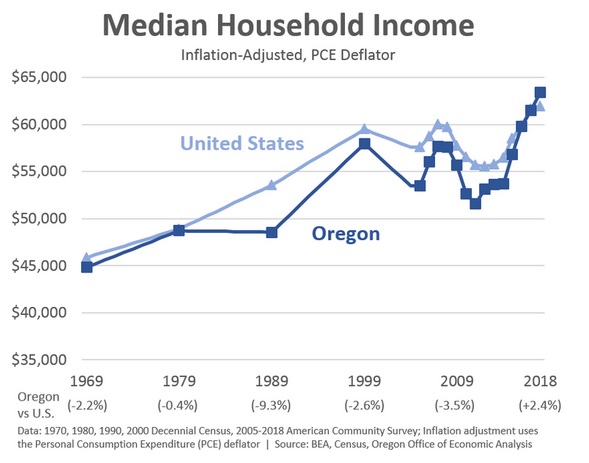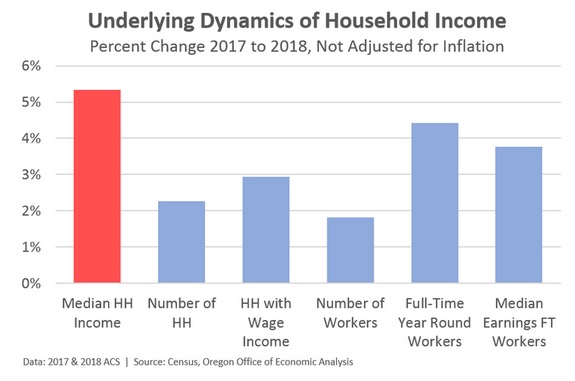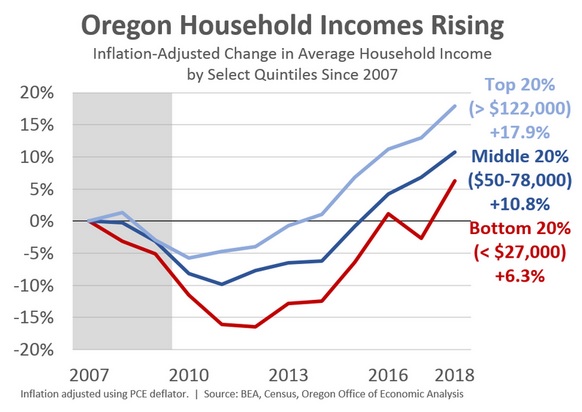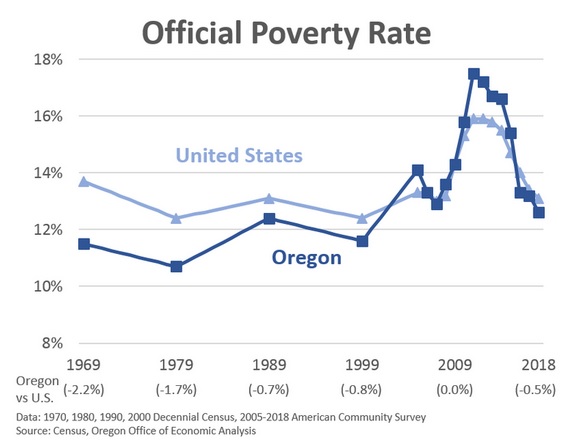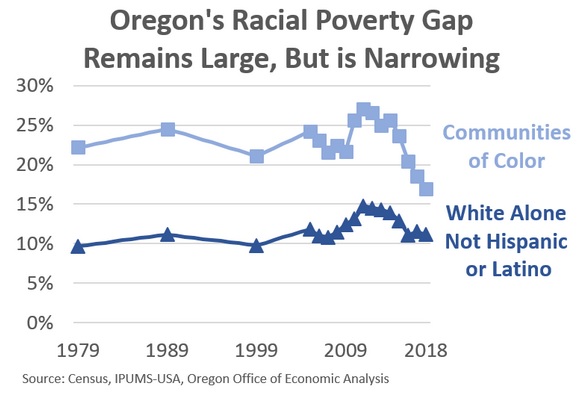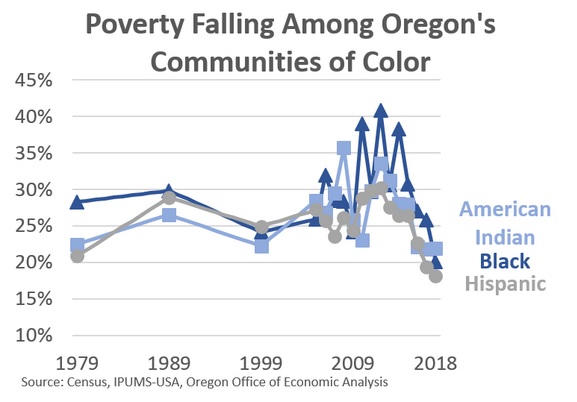By Josh Lehner,
Oregon Office of Economic Analysis
The Census Bureau released the 2018 American Community Survey data. There is a ton to unpack here and even more once the microdata is released later this year. In the coming months our office will update and share some of this work.
The latest Census data shows that Oregon’s economy continues to get better, with the gains reaching all corners and populations of the state. After 10 years of expansion, Oregon is now enjoying the best economy since the late 1990s and in some respects, reaching historic highs. Major economic markers like median household income and the poverty rate are showing ongoing improvements that outstrip gains across much of the country. Now, it is true, Oregon is transitioning down from peak growth rates a couple years ago in terms of job growth, but the tighter labor market is driving higher incomes as Oregonians work more hours and at higher wages. All of this data is backward looking and has little impact on the current economic outlook. However, it is always important to take stock of socioeconomic conditions and right now, the data is highly encouraging.
First, let’s take a look at historic trends in median household incomes here in Oregon and across the country. Not only has Oregon caught up to national figures, but in the latest data Oregon has surpassed the U.S. Today, the typical household in the state has income that is 2.4% higher than their national counterparts. This is the first time in past 50 years this is true. We have to go back to the 1960 Census to find a time when median incomes in Oregon where higher than national figures. Furthermore, incomes today on an inflation-adjusted basis are at all-time highs. This is true whether you use PCE or CPI as the deflator.
Oregon’s 2018 gains were the second fastest across all states, with only Idaho seeing strong gains. In looking at the major drivers of median household income in Oregon last year, they point toward the dynamics one would expect in a mature expansion and tighter labor market. Job growth is slower, but the number of Oregonians working full-time, and their earnings are growing faster than a year ago, boosting overall income growth in the state.
Income gains are seen across the spectrum. A year ago our office highlighted a potential worrisome spot as incomes dropped for the lowest quintile. We noted this was out of line with expectations and suspected it would reverse itself this year. Turns out that was right and on an inflation-adjusted basis, incomes for the bottom 20% of the population are now at historic highs as well. If we step back and look at income gains in the past few years, the growth is strongest in the lowest quintile, followed by the second and middle quintiles. Of course these households were the hardest hit during the recession and had further ground to regain. The good news is that ground has been regained, even if such households still struggle to make ends meet.
With stronger income gains among the bottom part of the distribution, Oregon’s poverty rate continues to decline. At 12.6% statewide, Oregon’s poverty rate is now half a percentage point below the U.S. which stands are 13.1%. Oregon’s poverty rate is now lower than it has been since 2000, and our relative position vis a vis the nation is nearly back to the differences seen at that time as well.
In decomposing the poverty rates just a little it shows the current economic expansion really is reaching all corners and populations. Census has changed the way they survey and define racial and ethnic groups over the decades. But as best I can tell, poverty rates among Oregon’s communities of color are at multi-decade lows, if not historic lows. A racial gap remains, as White, Not Hispanic or Latino Oregonians (and Americans) experience lower poverty rates. However the racial gap is narrowing as the expansion continues.
Specifically, this holds at least among Black Oregonians, American Indian Oregonians and Hispanic or Latino Oregonians. This is the extent of the historical data I have pieced together over the years. Keep in mind that there are some underlying definition changes here, but the chart tells an encouraging story.
Bottom Line: Oregon continues to be in the feel-good part of the business cycle. A strong economy works wonders, even if it cannot cure all ills. The benefits are now reaching all corners and populations of the state. At this point, the cyclical improvements are essentially gone and real progress is now being made in terms of socioeconomic conditions relative to the past couple of decades. Everything is not perfect of course. And gains moving forward may be harder to come by as the cycle matures and growth wanes a bit. That said, Oregon is now doing better than it was during the housing boom, and approaching the socioeconomic conditions the state last saw during the late 1970s and late 1990s.
Coming up this afternoon will be a high level look at household income trends in Oregon’s metro areas.
Disclaimer: Articles featured on Oregon Report are the creation, responsibility and opinion of the authoring individual or organization which is featured at the top of every article.

